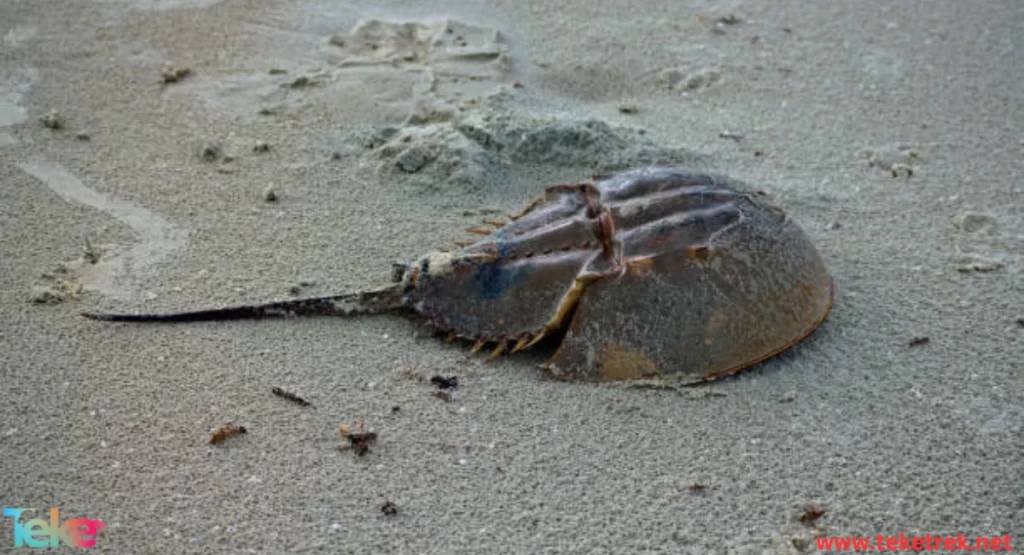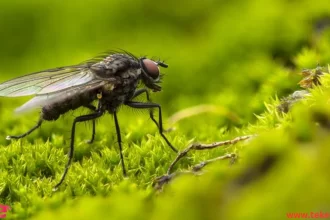The horseshoe crab is known for its large protective shell and is a wonderful example of a living fossil, as it is a remnant of ancient arthropods dating back approximately 450 million years.
Let’s learn more about it from teketrek.
Facts about the Horseshoe Crab
Horseshoe crabs are of the class Merostomata, of the division Arthropoda, of the family Limulidae, of the order Xiphosura.
Its scientific name is Limulidae, which means “aberrant” in Latin.
While other species have gone extinct, the horseshoe crab family has persisted, although human activity has significantly reduced their numbers.
The shell of the horseshoe crab is often covered with small organisms that move on it and feed on it.
Horseshoe crab meat is sometimes used as bait to catch American conger eels.
Throughout its life, the horseshoe crab undergoes several molting processes, with its size usually increasing each time.

The horseshoe crab specification
The shell: The horseshoe crab is distinguished by its round, attached shell made of a carbohydrate material called chitin, found in fish scales and fungal cell walls.
The body: Its body consists of 3 parts, some of which are hidden under the shell the large part is the shield, followed by the smaller abdomen located between the chest and pelvis.
The last part is the sharp spinal column that protrudes like a tail.
The Legs: The horseshoe crab has six pairs of legs, along with a pair of small appendages.
The Gills: The horseshoe crab has five pairs of gills located directly behind the legs for breathing and swimming.
https://teketrek.net/eurasian-eagle-owl-a-symbol-of-strength-and-wisdom/
Horseshoe crab habitat
Horseshoe crabs live in the waters of India, East Asia, and the Atlantic coast of the United States around river mouths where coastal waters meet rivers and ponds.
They move slowly along the seabed, capturing any prey they can find.
Horseshoe crabs are found in North America from Maine to South Florida, the Gulf of Mexico in the Yucatan Peninsula area.
Horseshoe Crab Diet
The horseshoe crab eats various mollusks, algae, and worms.
It is most active at night, particularly during the period of the full moon, when it digs in the sand to search for food.
It also consumes other foods such as small fish and crustaceans, making it a carnivorous animal.
Horseshoe crab evolution and reproduction
During the mating season, large numbers of horseshoe crabs migrate to shallow ocean waters, where the males select females.
The female horseshoe crab digs a large hole in the soft coastal sands, with the hole reaching a depth of approximately 15 cm.
The female then lays between 60, 000 to 120, 000 eggs in several batches at once.
After about 15 days, the eggs hatch, and the larvae molt six times in their first year.
https://teketrek.net/the-narrow-barred-spanish-discovering-the-unique-beauty-of-this-endangered-species/
Horseshoe crab species
There are four species of horseshoe crabs:
Atlantic or American horseshoe crab:
This is the only species living in North America, found in the waters off the eastern coast of the United States and the Gulf of Mexico.
Mangrove horseshoe crab:
Found in marine and brackish waters in India and Southeast Asia.
Indian horseshoe crab:
This species lives in the region between India and the Philippines.
Horseshoe crabs three spines:
Found in the area between Japan and Southeast Asia, this species is named after the three distinct parts of the spine, it is currently classified as endangered.

FAQ
- What is the Horseshoe crab lifespan?
The lifespan of a horseshoe crab ranges from 20 to 40 years.
- What is so special about horseshoe crab?
Horseshoe crabs have changed very little over more than 500 million years.
- Is a horseshoe crab Venomous?
First off, they’re not even crabs! They’re actually closer cousins to spiders or scorpions. They’re not dangerous.They lack teeth and jaws and are not venomous.
- Why is horseshoe crab blood valuable?
Horseshoe crab blood is used to produce a critical medical product that ensures the safety of many drugs and medical devices.
- Why is horseshoe crab blood so expensive?
Horseshoe crab blood is expensive because it is used to create limulus amebocyte lysate (LAL), a substance essential for detecting pathogens in crucial medicines like injectable antibiotics.
- Can we eat horseshoe crab?
It’s not especially good eating, either.
- Are horseshoe crabs endangered?
Yes, it is endangered.
In conclusion, it is important to highlight the significance of horseshoe crabs in maintaining ecological balance. They possess many astonishing facts that allow us to understand them more comprehensively.
References:





